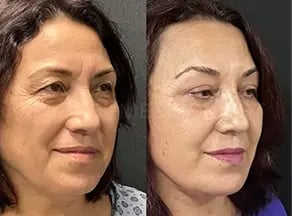Facelift
Facelift
- What is Facelift?
- What are the Pros and Cons of Facelift Surgery?
- How Much Does a Facelift Cost?
- What is the Ideal Age for a Facelift?
- What are the Different Types of Facelifts, and How are They Done?
- Does a Facelift Include the Neck?
- How Long Does Facelift Take to Recover?
- How Painful is a Facelift?
- What are the Risks of a Facelift?
- How Long Does a Facelift Last?
- What are the Alternatives to a Facelift?
- Facelift in Turkey

&Quick Facts
-
Satisfaction 88%
-
 Reviews 11
Reviews 11 -
 Average Cost $ 4500
Average Cost $ 4500 -
 Related Doctors 7
Related Doctors 7 -
 Local sedation or general anesthesia
Local sedation or general anesthesia -
 Recovery Time 10-14 Days
Recovery Time 10-14 Days -
 Question&Answer 4
Question&Answer 4

It is the result of the face lift performed by Tahsin Gorgulu, MD. For reference purposes only, results may vary.
&Doctors
Most Active Doctors on NewMe
&Real Reviews
Most Related Review
&Real Reviews
Real Reviews Q&A




&All About Facelift
&All About Facelift
What is Facelift?
Facelift, or rhytidectomy, is a cosmetic surgery that reduces facial and neck aging signs. It involves tightening the facial muscles, removing excess skin, and smoothing out wrinkles to create a more youthful appearance.
Addressing sagging skin and deep creases, it can help rejuvenate the face and restore a firmer, more refreshed look.
Before undergoing this surgery, it's important to talk to a skilled plastic surgeon. Talk to him about your goals, possible risks, and expected results.
What are the Pros and Cons of Facelift Surgery?
Youthful Appearance: Tightening sagging skin and reducing wrinkles can help achieve a more youthful appearance.
Improved Self-Confidence: Many individuals experience increased self-confidence and improved self-esteem following successful surgery.
Long-Lasting Results: While not permanent, the results can last several years, offering lasting benefits.
Cons of Facelift Surgery:
Risks and Complications: Like any surgery, it carries risks such as infection, scarring, or adverse reactions to general anaesthetic.
Recovery Time: Recovery from a facelift may involve swelling, bruising, and discomfort, requiring time off from regular activities.
Expense: Facelift surgery can be expensive. Insurance usually doesn't cover it because it's considered a cosmetic procedure.

How Much Does a Facelift Cost?
The cost of a facelift varies based on several factors. For example the surgeon's expertise, geographic location, and the extent of the procedure. On average, facelift prices can range from $7,000 to $15,000.
People need to consult with a plastic surgeon for an accurate cost estimate tailored to individual needs. Remember that additional expenses like anesthesia, facility fees, and post-operative care may contribute to the total cost.
Always prioritize a consultation to understand the specifics and financial aspects of undergoing surgery.
Click for more information
Our mission is to create a world where every investment in modern beauty is Worth It.
Let's keep in touch
Get updates on the treatments you are interested
What is the Ideal Age for a Facelift?
For younger individuals, non-surgical treatments like fillers might suffice. Consulting with a qualified surgeon helps determine the best approach based on individual needs.

What are the Different Types of Facelifts, and How are They Done?
There are various types of facelifts, each focusing on specific areas and achieving distinct results.
Traditional Facelift: Full facelift method involves incisions along the hairline, extending around the ear. The surgeon tightens underlying tissues, removes excess skin, and repositions facial contours for a younger appearance.
Mini Facelift: Also known as a "mini face lift," it's less invasive than the traditional option. Doctors make smaller incisions mainly to target sagging skin in the lower face and jawline.
Mid-Facelift: Targets the middle of the face, concentrating on the cheeks and under-eye areas. Surgeons usually make incisions near the lower eyelids or mouth to lift sagging tissues.
Thread Lift: This technique involves placing dissolvable threads under the skin. Aime is lifting and tightening particular areas of the face with minimal invasion. Results are temporary but can provide a subtle lift.
Procedure Details: Generally involve anesthesia, incisions, skin repositioning, and sutures. The exact technique depends on the type of facelift and individual needs.
1. Preparation: Before the surgery, you'll have consultations with your surgeon to discuss your goals and medical history.
2. Anesthesia: Surgeons use either local or general anesthesia for the procedure. Local anesthesia numbs the area, while general anesthesia puts you to sleep.
3. Incisions: Plastic surgeons usually make cuts in front of the ear. Sometimes extending around the earlobe and into the hairline. Local anaesthetic can be used.
4. Lifting and Tightening: Surgeons lift and reposition facial skin. The soft tissues underneath to reduce sagging and wrinkles.
5. Eyelid Surgery and Brow Lift: Sometimes, surgeons combine a facelift with eyelid surgery. Brow lift for a more complete rejuvenation.
6. Post-Surgery: After the procedure, you'll in a recovery area. They will monitoring your initial recovery from the effects of anesthesia.
7. Recovery: The day after surgery people feel good. Recovery times differ, but most people can return to work within a few weeks.
8. Final Result: As swelling and bruising decrease. You'll start seeing the final result of a facelift, typically a few weeks after surgery.
Following post-operative instructions is important. This will bring optimal healing and the outcome in improving facial appearance and signs of aging.
Does a Facelift Include the Neck?
A facelift surgery primarily focuses on rejuvenating the face. However, it's essential to note that a facelift can indeed address the neck area too. This procedure targets sagging skin, wrinkles, and jowls around the lower face and jawline.
Simultaneously, it involves tightening the muscles and tissues of the neck to create a more youthful appearance. A facelift aims to create a smoother, firmer look.
This will improve the contours of the face and neck, and refresh the overall facial profile.

How Long Does Facelift Take to Recover?
After undergoing this surgery, the recovery period varies for each person. Generally, it takes around 2 to 4 weeks to visibly notice improvements and resume normal activities. Initially, you might experience swelling and bruising, which gradually subside.
Adhering strictly to your surgeon's post-operative instructions aids in a smoother recovery. Remember, patience is key for the healing process to achieve optimal results.
Click for more information
How Painful is a Facelift?
Facelift surgery is generally well-tolerated, but discomfort varies for each individual. Patients may experience mild to moderate soreness or tightness in the treated areas post-operation. This is manageable with prescribed pain relief medication.
Swelling and bruising are common but subside within a few weeks. Ensuring proper rest and following post-operative instructions diligently aids in minimizing discomfort. While discomfort is part of the recovery process, the results obtained often outweigh this temporary inconvenience.
Click for more information

What are the Risks of a Facelift?
This may come with potential risks like any other surgical procedure. These risks include bleeding, infection, and reactions to anesthesia.
Additionally, there might be a chance of scarring or changes in skin sensation after the surgery. Some individuals might also experience temporary bruising or swelling.
How Long Does a Facelift Last?
How long a lasts differs for each person and depends on factors such as skin type, lifestyle, and the quality of the procedure.
Generally, outcomes can last anywhere from five to fifteen years. However, the aging process continues, and the face will gradually age again over time. The procedure doesn't halt the natural aging process; it simply resets the clock to a more youthful appearance.
To prolong the results, adopt a healthy lifestyle, apply sunscreen, and stick to a good skincare routine to slow down aging.
Additionally, considering non-invasive procedures or touch-up surgeries later on can further prolong the effects.

What are the Alternatives to a Facelift?
There are alternative treatments that don’t involve surgery. Non-surgical options like dermal fillers, Botox injections, and laser therapy can help reduce wrinkles and tighten skin. These procedures are less invasive and have shorter recovery periods compared to lifting the face.
Additionally, skincare routines, healthy lifestyle choices, and facial exercises can contribute to maintaining youthful skin.
Facelift in Turkey
This cosmetic procedure aims to revitalize and tighten facial skin, reducing wrinkles and sagging. By skillfully repositioning facial tissues, surgeons restore a youthful appearance in Turkey. The process involves removing excess skin and gently lifting deeper tissues.
Turkey has skilled facelift surgeons and modern facilities, attracting those seeking facial rejuvenation to this sought-after destination. This safe and effective surgery results in a more youthful, refreshed look, enhancing self-confidence.
What is Facelift?
Facelift, or rhytidectomy, is a cosmetic surgery that reduces facial and neck aging signs. It involves tightening the facial muscles, removing excess skin, and smoothing out wrinkles to create a more youthful appearance.
Addressing sagging skin and deep creases, it can help rejuvenate the face and restore a firmer, more refreshed look.
Before undergoing this surgery, it's important to talk to a skilled plastic surgeon. Talk to him about your goals, possible risks, and expected results.
What are the Pros and Cons of Facelift Surgery?
Youthful Appearance: Tightening sagging skin and reducing wrinkles can help achieve a more youthful appearance.
Improved Self-Confidence: Many individuals experience increased self-confidence and improved self-esteem following successful surgery.
Long-Lasting Results: While not permanent, the results can last several years, offering lasting benefits.
Cons of Facelift Surgery:
Risks and Complications: Like any surgery, it carries risks such as infection, scarring, or adverse reactions to general anaesthetic.
Recovery Time: Recovery from a facelift may involve swelling, bruising, and discomfort, requiring time off from regular activities.
Expense: Facelift surgery can be expensive. Insurance usually doesn't cover it because it's considered a cosmetic procedure.

How Much Does a Facelift Cost?
The cost of a facelift varies based on several factors. For example the surgeon's expertise, geographic location, and the extent of the procedure. On average, facelift prices can range from $7,000 to $15,000.
People need to consult with a plastic surgeon for an accurate cost estimate tailored to individual needs. Remember that additional expenses like anesthesia, facility fees, and post-operative care may contribute to the total cost.
Always prioritize a consultation to understand the specifics and financial aspects of undergoing surgery.
Click for more information
Our mission is to create a world where every investment in modern beauty is Worth It.
Let's keep in touch
Get updates on the treatments you are interested
What is the Ideal Age for a Facelift?
For younger individuals, non-surgical treatments like fillers might suffice. Consulting with a qualified surgeon helps determine the best approach based on individual needs.

What are the Different Types of Facelifts, and How are They Done?
There are various types of facelifts, each focusing on specific areas and achieving distinct results.
Traditional Facelift: Full facelift method involves incisions along the hairline, extending around the ear. The surgeon tightens underlying tissues, removes excess skin, and repositions facial contours for a younger appearance.
Mini Facelift: Also known as a "mini face lift," it's less invasive than the traditional option. Doctors make smaller incisions mainly to target sagging skin in the lower face and jawline.
Mid-Facelift: Targets the middle of the face, concentrating on the cheeks and under-eye areas. Surgeons usually make incisions near the lower eyelids or mouth to lift sagging tissues.
Thread Lift: This technique involves placing dissolvable threads under the skin. Aime is lifting and tightening particular areas of the face with minimal invasion. Results are temporary but can provide a subtle lift.
Procedure Details: Generally involve anesthesia, incisions, skin repositioning, and sutures. The exact technique depends on the type of facelift and individual needs.
1. Preparation: Before the surgery, you'll have consultations with your surgeon to discuss your goals and medical history.
2. Anesthesia: Surgeons use either local or general anesthesia for the procedure. Local anesthesia numbs the area, while general anesthesia puts you to sleep.
3. Incisions: Plastic surgeons usually make cuts in front of the ear. Sometimes extending around the earlobe and into the hairline. Local anaesthetic can be used.
4. Lifting and Tightening: Surgeons lift and reposition facial skin. The soft tissues underneath to reduce sagging and wrinkles.
5. Eyelid Surgery and Brow Lift: Sometimes, surgeons combine a facelift with eyelid surgery. Brow lift for a more complete rejuvenation.
6. Post-Surgery: After the procedure, you'll in a recovery area. They will monitoring your initial recovery from the effects of anesthesia.
7. Recovery: The day after surgery people feel good. Recovery times differ, but most people can return to work within a few weeks.
8. Final Result: As swelling and bruising decrease. You'll start seeing the final result of a facelift, typically a few weeks after surgery.
Following post-operative instructions is important. This will bring optimal healing and the outcome in improving facial appearance and signs of aging.
Does a Facelift Include the Neck?
A facelift surgery primarily focuses on rejuvenating the face. However, it's essential to note that a facelift can indeed address the neck area too. This procedure targets sagging skin, wrinkles, and jowls around the lower face and jawline.
Simultaneously, it involves tightening the muscles and tissues of the neck to create a more youthful appearance. A facelift aims to create a smoother, firmer look.
This will improve the contours of the face and neck, and refresh the overall facial profile.

How Long Does Facelift Take to Recover?
After undergoing this surgery, the recovery period varies for each person. Generally, it takes around 2 to 4 weeks to visibly notice improvements and resume normal activities. Initially, you might experience swelling and bruising, which gradually subside.
Adhering strictly to your surgeon's post-operative instructions aids in a smoother recovery. Remember, patience is key for the healing process to achieve optimal results.
Click for more information
How Painful is a Facelift?
Facelift surgery is generally well-tolerated, but discomfort varies for each individual. Patients may experience mild to moderate soreness or tightness in the treated areas post-operation. This is manageable with prescribed pain relief medication.
Swelling and bruising are common but subside within a few weeks. Ensuring proper rest and following post-operative instructions diligently aids in minimizing discomfort. While discomfort is part of the recovery process, the results obtained often outweigh this temporary inconvenience.
Click for more information

What are the Risks of a Facelift?
This may come with potential risks like any other surgical procedure. These risks include bleeding, infection, and reactions to anesthesia.
Additionally, there might be a chance of scarring or changes in skin sensation after the surgery. Some individuals might also experience temporary bruising or swelling.
How Long Does a Facelift Last?
How long a lasts differs for each person and depends on factors such as skin type, lifestyle, and the quality of the procedure.
Generally, outcomes can last anywhere from five to fifteen years. However, the aging process continues, and the face will gradually age again over time. The procedure doesn't halt the natural aging process; it simply resets the clock to a more youthful appearance.
To prolong the results, adopt a healthy lifestyle, apply sunscreen, and stick to a good skincare routine to slow down aging.
Additionally, considering non-invasive procedures or touch-up surgeries later on can further prolong the effects.

What are the Alternatives to a Facelift?
There are alternative treatments that don’t involve surgery. Non-surgical options like dermal fillers, Botox injections, and laser therapy can help reduce wrinkles and tighten skin. These procedures are less invasive and have shorter recovery periods compared to lifting the face.
Additionally, skincare routines, healthy lifestyle choices, and facial exercises can contribute to maintaining youthful skin.
Facelift in Turkey
This cosmetic procedure aims to revitalize and tighten facial skin, reducing wrinkles and sagging. By skillfully repositioning facial tissues, surgeons restore a youthful appearance in Turkey. The process involves removing excess skin and gently lifting deeper tissues.
Turkey has skilled facelift surgeons and modern facilities, attracting those seeking facial rejuvenation to this sought-after destination. This safe and effective surgery results in a more youthful, refreshed look, enhancing self-confidence.











.webp?width=200&height=200&name=thread-lift%20(1).webp)





